Totally percutaneous versus surgical cut-down femoral artery access for elective bifurcated abdominal endovascular aneurysm repair
- PMID: 36629152
- PMCID: PMC9832535
- DOI: 10.1002/14651858.CD010185.pub4
Totally percutaneous versus surgical cut-down femoral artery access for elective bifurcated abdominal endovascular aneurysm repair
Abstract
Background: Abdominal aortic aneurysms (AAAs) are a vascular condition with significant risk attached, particularly if they rupture. Therefore, it is critical to identify and repair these as an elective procedure before they rupture and require emergency surgery. Repair has traditionally been an open surgical technique that required a large incision across the abdomen. Endovascular abdominal aortic aneurysm repairs (EVARs) are now a common alternative. In this procedure, the common femoral artery is exposed via a cut-down approach and a graft is introduced to the aneurysm in this way. This Cochrane Review examines a totally percutaneous approach to EVAR. This technique gives a minimally invasive approach to femoral artery access that may reduce groin wound complication rates and improve recovery time. However, the technique may be less applicable in people with, for example, groin scarring or arterial calcification. This is an update of the previous Cochrane Review published in 2017.
Objectives: To evaluate the benefits and harms of totally percutaneous access compared to cut-down femoral artery access in people undergoing elective bifurcated abdominal endovascular aneurysm repair (EVAR).
Search methods: We used standard, extensive Cochrane search methods The latest search was 8 April 2022.
Selection criteria: We included randomised controlled trials in people diagnosed with an AAA comparing totally percutaneous versus surgical cut-down access endovascular repair. We considered all device types. We only considered studies investigating elective repairs. We excluded studies reporting emergency surgery for ruptured AAAs and those reporting aorto-uni-iliac repairs.
Data collection and analysis: We used standard Cochrane methods. Our primary outcomes were 1. short-term mortality, 2. failure of aneurysm exclusion and 3. wound infection. Secondary outcomes were 4. major complications (30-day or in-hospital); 5. medium- to long-term (6 and 12 months) complications and mortality; 6. bleeding complications and haematoma; and 7. operating time, duration of intensive treatment unit (ITU) stay and hospital stay. We used GRADE to assess the certainty of evidence for the seven most clinically relevant primary and secondary outcomes.
Main results: Three studies with 318 participants met the inclusion criteria, 189 undergoing the percutaneous technique and 129 treated by cut-down femoral artery access. One study had a small sample size and did not adequately report the method of randomisation, allocation concealment or preselected outcomes. The other two larger studies had few sources of bias and good methodology; although one study had a high risk of bias in selective reporting. We observed no clear difference in short-term mortality between groups, with only one death occurring overall, in the totally percutaneous group (risk ratio (RR) 1.50, 95% confidence interval (CI) 0.06 to 36.18; 2 studies, 181 participants; low-certainty evidence). One study reported failure of aneurysm exclusion. There was one failure of aneurysm exclusion in the surgical cut-down femoral artery access group (RR 0.17, 95% CI 0.01 to 4.02; 1 study, 151 participants; moderate-certainty evidence). For wound infection, there was no clear difference between groups (RR 0.18, 95% CI 0.01 to 3.59; 3 studies, 318 participants; moderate-certainty evidence). There was no clear difference between percutaneous and cut-down femoral artery access groups in major complications (RR 1.21, 95% CI 0.61 to 2.41; 3 studies, 318 participants; moderate-certainty evidence), bleeding complications (RR 1.02, 95% CI 0.29 to 3.64; 2 studies, 181 participants; moderate-certainty evidence) or haematoma (RR 0.88, 95% CI 0.13 to 6.05; 2 studies, 288 participants). One study reported medium- to long-term complications at six months, with no clear differences between the percutaneous and cut-down femoral artery access groups (RR 0.82, 95% CI 0.25 to 2.65; 1 study, 135 participants; moderate-certainty evidence). We detected differences in operating time, with the percutaneous approach being faster than cut-down femoral artery access (mean difference (MD) -21.13 minutes, 95% CI -41.74 to -0.53 minutes; 3 studies, 318 participants; low-certainty evidence). One study reported the duration of ITU stay and hospital stay, with no clear difference between groups.
Authors' conclusions: Skin puncture may make little to no difference to short-term mortality. There is probably little or no difference in failure of aneurysm exclusion (failure to seal the aneurysms), wound infection, major complications within 30 days or while in hospital, medium- to long-term (six months) complications and bleeding complications between the two groups. Compared with exposing the femoral artery, skin puncture may reduce the operating time slightly. We downgraded the certainty of the evidence to moderate and low as a result of imprecision due to the small number of participants, low event rates and wide CIs, and inconsistency due to clinical heterogeneity. As the number of included studies was limited, further research into this technique would be beneficial.
Trial registration: ClinicalTrials.gov NCT01070069.
Copyright © 2023 The Cochrane Collaboration. Published by John Wiley & Sons, Ltd.
Conflict of interest statement
QW: none.
JW: none
YM: none.
YZ: none.
XS: none.
SX: none.
FL: none.
MG: none.
ML: none.
LY: none.
Figures
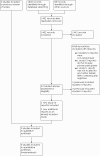


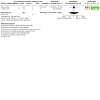

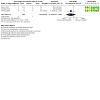
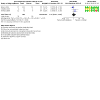

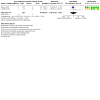
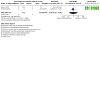



Update of
-
Totally percutaneous versus surgical cut-down femoral artery access for elective bifurcated abdominal endovascular aneurysm repair.Cochrane Database Syst Rev. 2017 Feb 21;2(2):CD010185. doi: 10.1002/14651858.CD010185.pub3. Cochrane Database Syst Rev. 2017. Update in: Cochrane Database Syst Rev. 2023 Jan 11;1:CD010185. doi: 10.1002/14651858.CD010185.pub4. PMID: 28221665 Free PMC article. Updated.
References
References to studies included in this review
Nelson 2014 {published data only}
-
- NCT01070069. Percutaneous endovascular aneurysm repair (PEVAR) trial (PEVAR) [Prospective, multicenter, randomized controlled trial of endovascular aneurysm repair using a bilateral percutaneous approach (PEVAR) vs. standard approach (SEVAR) using the IntuiTrak endovascular AAA delivery system and the Prostar XL or Perclose ProGlide suture-mediated closure system]. clinicaltrials.gov/ct2/show/NCT01070069 (first received 17 February 2010).
-
- Nelson PR, Kracjer Z, Kansal N, Rao V, Bianchi C, Hashemi H, et al. A multicenter, randomized, controlled trial of totally percutaneous access versus open femoral exposure for endovascular aortic aneurysm repair (the PEVAR trial). Journal of Vascular Surgery 2014;59(5):1181-93. - PubMed
-
- Nelson PR. Percutaneous endovascular aortic aneurysm repair (PEVAR): results from the first prospective, multicenter randomized trial. Journal of Vascular Surgery 2012;56(6):1816. [DOI: 10.1016/j.jvs.2012.10.023] - DOI
Torsello 2003 {published data only}
-
- Torsello GB, Kasprzak B, Klenk E, Tessarek J, Osada N, Torsello GF. Endovascular suture versus cutdown for endovascular aneurysm repair: a prospective randomized pilot study. Journal of Vascular Surgery 2003;38(1):78-82. - PubMed
Vierhout 2019 {published data only}NTR4257
-
- Vierhout BP, Pierie ME, Andringa de Kempenaer TD, Hissink RJ, Wikkeling OR, Bottema J, et al. Clinical outcome of percutaneous EVAR versus EVAR through open surgical cut down (PiERO): a multicenter randomized clinical trial. Vascular 2016;24(1S):40. [DOI: 10.1177/1708538116673764] - DOI
-
- Vierhout BP, Saleem BR, Ott A, Dijl JM, Andringa de Kempenaer TD, Pierie ME, et al. A comparison of Percutaneous femoral access in Endovascular Repair versus Open femoral access (PiERO): study protocol for a randomized controlled trial. Trials 2015;16:408. [DOI: 10.1186/s13063-015-0911-y] - DOI - PMC - PubMed
References to studies excluded from this review
Hattab 2012 {published data only}
-
- Hattab M, Hakim M, Carreira VB, Elhadad S. TCT-393 A randomized trial comparing two vascular closure devices: PROGLIDE and the novel EXOSEAL after percutaneous femoral procedures. Journal of the American College of Cardiology 2012;60(17_S):B112.
Ichihashi 2016 {published data only}
-
- Ichihashi T, Ito T, Kinoshita Y, Suzuki T, Ohte N. Safety and utility of total percutaneous endovascular aortic repair with a single Perclose ProGlide closure device. Journal of Vascular Surgery 2016;63(3):585-8. - PubMed
Iłżecki 2018 {published data only}
-
- Iłżecki M, Majewski M, Terlecki P, Przywara S, Rogala W, Rybak J, et al. The utility of Prostar XL percutaneous vascular closure device after stent-graft implantation for infrarenal abdominal aortic aneurysms. Acta Angiologica 2018;24(3):74-9.
Jean‐Baptiste 2008 {published data only}
-
- Jean-Baptiste E, Hassen-Khodja R, Haudebourg P, Bouillanne PJ, Declemy S, Batt M. Percutaneous closure devices for endovascular repair of infrarenal abdominal aortic aneurysms: a prospective, non-randomized comparative study. European Journal of Vascular and Endovascular Surgery 2008;35(4):422-8. - PubMed
Krajcer 2010 {published data only}
-
- Krajcer Z, Gregoric I. Totally percutaneous aortic aneurysm repair: methods and outcomes using the fully integrated IntuiTrak endovascular system. Journal of Cardiovascular Surgery 2010;51(4):493-501. - PubMed
Krajcer 2011 {published data only}
-
- Krajcer Z, Nelson P, Bianchi C, Rao V, Morasch M, Bacharach J. Percutaneous endovascular abdominal aortic aneurysm repair: methods and initial outcomes from the first prospective, multicenter trial. Journal of Cardiovascular Surgery 2011;525(55):651-9. [PMID: ] - PubMed
NTR4225 {unpublished data only}
-
- NTR4225. Do minimal invasive techniques inflict less surgical site infections than open access to the femoral artery, in endovascular abdominal aneurysm repair? www.trialregister.nl/ 2013.
Pitton 2003 {published data only}
-
- Pitton MB, Schweitzer H, Herber S, Schmiedt W, Neufang A, Düber C, et al. Endovascular therapy of abdominal aortic aneurysm: results of a mid-term follow-up [Endovaskuläre Therapie von abdominellen Aortenaneurysmen: Klinisch-radiologische Ergebnisse im mittelfristigen Verlauf]. Rofo: Fortschritte auf dem Gebiete der Rontgenstrahlen und der Nuklearmedizin 2003;175(10):1392-402. - PubMed
Roche‐Nagle 2018 {published data only}
-
- Roche-Nagle G, Hazel M, Rajan DK. Financial impact of PEVAR compared with standard endovascular repair in Canadian hospitals. Canadian Association of Radiologists Journal 2018;69(2):215-9. - PubMed
Uhlmann 2018 {published data only}
-
- NCT02822560. Economic comparison of percutaneous (PEVAR) vs. open access in EVAR. (EVAccess) [Comparative clinical and economic analysis of percutaneous vs. open access for endovascular aortic repair – a prospective, randomised trial]. clinicaltrials.gov/ct2/show/NCT02822560 (first received 4 July 2016).
-
- Uhlmann M, Walter C, Taher F, Plimon M, Falkensammer J, Assadian A. Percutaneous access for EVAR decreases procedural costs – a randomised prospective trial. Zeitschrift für Gefäßmedizin 2017;14(3):24.
-
- Uhlmann ME, Walter C, Taher F, Plimon M, Falkensammer J, Assadian A. Successful percutaneous access for endovascular aneurysm repair is significantly cheaper than femoral cutdown in a prospective randomized trial. Journal of Vascular Surgery 2018;68(2):384-91. - PubMed
Xiong 2012 {published data only}
-
- Xiong J, Wei R, Guo W, Liu X, Jia X, Ma X, et al. Comparison of early effectiveness between total percutaneous endovascular aneurysm repair and surgical femoral cutdown endovascular aneurysm repair for asymptomatic abdominal aortic aneurysm. Zhongguo Xiu Fu Chong Jian Wai Ke Za Zhi [Chinese Journal of Reparative and Reconstructive Surgery] 2012;26(11):1348-51. - PubMed
Additional references
Antoniou 2021
-
- Antoniou GA, Antoniou SA. Editor's Choice – percutaneous access does not confer superior clinical outcomes over cutdown access for endovascular aneurysm repair: meta-analysis and trial sequential analysis of randomised controlled trials. European Journal of Vascular and Endovascular Surgery 2021;61(3):383-94. - PubMed
Bi 2022
Chambers 2009
-
- Chambers D, Epstein D, Walker S, Fayter D, Paton F, Wright K, et al. Endovascular stents for abdominal aortic aneurysms: a systematic review and economic model. Health Technology Assessment 2009;13(48):1-189, 215-318, iii. - PubMed
Chan 2021
-
- Chan WK, Yong E, Hong Q, Zhang L, Lingam P, Tan GW, et al. Systematic review and meta-analysis of the prevalence of abdominal aortic aneurysm in Asian populations. Journal of Vascular Surgery 2021;73(3):1069-74. - PubMed
Covidence [Computer program]
-
- Covidence. Version accessed 8 April 2022. Melbourne, Australia: Veritas Health Innovation. Available at covidence.org.
Dalainas 2004
-
- Dalainas I, Nano G, Casana R, Tealdi DG. Mid-term results after endovascular repair of abdominal aortic aneurysms: a four-year experience. European Journal of Vascular and Endovascular Surgery 2004;27(3):319-23. - PubMed
Deeks 2022
-
- Deeks JJ, Higgins JP, Altman DG. Chapter 10: Analysing data and undertaking meta-analyses. In: Higgins JP, Thomas J, Chandler J, Cumpston M, Li T, Page MJ, Welch VA, editor(s). Cochrane Handbook for Systematic Reviews of Interventions Version 6.3 (updated February 2022). Cochrane, 2022. Available from training.cochrane.org/handbook.
Dosluoglu 2007
-
- Dosluoglu HH, Cherr GS, Harris LM, Dryjski ML. Total percutaneous endovascular repair of abdominal aortic aneurysms using Perclose ProGlide closure devices. Journal of Endovascular Therapy 2007;14(2):184-8. - PubMed
Egger 1997
Faries 2002
-
- Faries PL, Brener BJ, Connelly TL, Katzen BT, Briggs VL, Burks JA Jr, et al. A multicenter experience with the Talent endovascular graft for the treatment of abdominal aortic aneurysms. Journal of Vascular Surgery 2002;35(6):1123-8. - PubMed
GRADEpro GDT [Computer program]
-
- GRADEpro GDT. Version accessed 15 July 2022. Hamilton (ON): McMaster University (developed by Evidence Prime). Available at gradepro.org.
Guirguis‐Blake 2019
-
- Guirguis-Blake JM, Beil TL, Senger CA, Coppola EL. Primary care screening for abdominal aortic aneurysm: updated evidence report and systematic review for the US Preventive Services Task Force. JAMA 2019;322(22):2219-38. - PubMed
Guyatt 2008
Higgins 2003
Higgins 2017
-
- Higgins JP, Altman DG, Sterne JA. Chapter 8: Assessing risk of bias in included studies. In: Higgins JP, Churchill R, Chandler J, Cumpston MS. editor(s), Cochrane Handbook for Systematic Reviews of Interventions Version 5.2.0 (updated June 2017), Cochrane, 2017. Available from training.cochrane.org/handbook/archive/v5.2/.
Higgins 2022
-
- Higgins JP, Thomas J, Chandler J, Cumpston M, Li T, Page MJ, Welch VA, editor(s). Cochrane Handbook for Systematic Reviews of Interventions Version 6.3 (updated February 2022). Cochrane, 2022. Available from www.training.cochrane.org/handbook.
Jacomelli 2017
-
- Jacomelli J, Summers L, Stevenson A, Lees T, Earnshaw JJ. Editor's choice – inequalities in abdominal aortic aneurysm screening in England: effects of social deprivation and ethnicity. European Journal of Vascular and Endovascular Surgery 2017;53(6):837-43. - PubMed
Jahangir 2015
-
- Jahangir E, Lipworth L, Edwards TL, Kabagambe EK, Mumma MT, Mensah GA, et al. Smoking, sex, risk factors and abdominal aortic aneurysms: a prospective study of 18 782 persons aged above 65 years in the Southern Community Cohort Study. Journal of Epidemiology and Community Health 2015;69(5):481-8. - PMC - PubMed
Kauvar 2016
-
- Kauvar DS, Martin ED, Givens MD. Thirty-day outcomes after elective percutaneous or open endovascular repair of abdominal aortic aneurysms. Annals of Vascular Surgery 2016;31:46-51. - PubMed
Kent 2010
-
- Kent KC, Zwolak RM, Egorova NN, Riles TS, Manganaro A, Moskowitz AJ, et al. Analysis of risk factors for abdominal aortic aneurysm in a cohort of more than 3 million individuals. Journal of Vascular Surgery 2010;52(3):539-48. - PubMed
Krajcer 2013
Larzon 2006
-
- Larzon T, Geijer H, Gruber G, Popek R, Norgren L. Fascia suturing of large access sites after endovascular treatment of aortic aneurysms and dissections. Journal of Endovascular Therapy 2006;13(2):152-7. - PubMed
Larzon 2015
-
- Larzon T, Roos H, Gruber G, Henrikson O, Magnuson A, Falkenberg M, et al. Editor's choice – a randomized controlled trial of the fascia suture technique compared with a suture-mediated closure device for femoral arterial closure after endovascular aortic repair. European Journal of Vascular and Endovascular Surgery 2015;49(2):166-73. - PubMed
Lee 2008
-
- Lee WA, Brown MP, Nelson PR, Huber TS, Seeger JM. Midterm outcomes of femoral arteries after percutaneous endovascular aortic repair using the Preclose technique. Journal of Vascular Surgery 2008;47(5):919-23. - PubMed
Lefebvre 2022
-
- Lefebvre C, Glanville J, Briscoe S, Featherstone R, Littlewood A, Marshall C, et al. Chapter 4: Searching for and selecting studies. In: Higgins JP, Thomas J, Chandler J, Cumpston M, Li T, Page MJ, Welch VA, editor(s). Cochrane Handbook for Systematic Reviews of Interventions Version 6.3 (updated February 2022). Cochrane, 2022. Available from training.cochrane.org/handbook.
Malkawi 2010
-
- Malkawi AH, Hinchliffe RJ, Holt PJ, Loftus IM, Thompson MM. Percutaneous access for endovascular aneurysm repair: a systematic review. European Journal of Vascular and Endovascular Surgery 2010;39(6):676-82. - PubMed
NCT01070069
-
- NCT01070069. Percutaneous endovascular aneurysm repair (PEVAR) trial (PEVAR) [Prospective, multicenter, randomized controlled trial of endovascular aneurysm repair using a bilateral percutaneous approach (PEVAR) vs. standard approach (SEVAR) using the IntuiTrak endovascular AAA delivery system and the Prostar XL or Perclose ProGlide suture-mediated closure system]. clinicaltrials.gov/ct2/show/NCT01070069 (first received 17 February 2010).
NCT02822560
-
- NCT02822560. Economic comparison of percutaneous (PEVAR) vs. open access in EVAR. (EVAccess) [Comparative clinical and economic analysis of percutaneous vs. open access for endovascular aortic repair – a prospective, randomised trial]. clinicaltrials.gov/ct2/show/NCT02822560 (first received 4 July 2016).
Nelson 2012
-
- Nelson PR. Percutaneous endovascular aortic aneurysm repair (PEVAR): results from the first prospective, multicenter randomized trial. Journal of Vascular Surgery 2012;56(6):1816. [DOI: 10.1016/j.jvs.2012.10.023] - DOI
Ngetich 2020
Owens 2019
-
- Owens DK, Davidson KW, Krist AH, Barry MJ, Cabana M, Caughey AB, et al. Screening for abdominal aortic aneurysm: US Preventive Services Task Force recommendation statement. JAMA 2019;322(22):2211-8. - PubMed
Page 2021a
Page 2021b
Papazoglou 1999
-
- Papazoglou K, Christu K, Iordanides T, Balitas A, Giakoystides D, Giakoystides E, et al. Endovascular abdominal aortic aneurysm repair with percutaneous transfemoral prostheses deployment under local anaesthesia. Initial experience with a new, simple-to-use tubular and bifurcated device in the first 27 cases. European Journal of Vascular and Endovascular Surgery 1999;17(3):202-7. - PubMed
Parodi 1991
-
- Parodi JC, Palmaz JC, Barone HD. Transfemoral intraluminal graft implantation for abdominal aortic aneurysms. Annals of Vascular Surgery 1991;5(6):491-9. - PubMed
RevMan Web 2022 [Computer program]
-
- Review Manager Web (RevMan Web). Version 4.12.0. The Cochrane Collaboration, 2022. Available at revman.cochrane.org.
Rutherford 2005
-
- Rutherford RB, editor. Vascular Surgery. 6th edition. Philadelphia (PA): Elsevier Saunders, 2005.
Schünemann 2022a
-
- Schünemann HJ, Higgins JP, Vist GE, Glasziou P, Akl EA, Skoetz N, et al. Chapter 14: Completing 'Summary of findings' tables and grading the certainty of the evidence. In: Higgins JP, Thomas J, Chandler J, Cumpston M, Li T, Page MJ, Welch VA, editor(s). Cochrane Handbook for Systematic Reviews of Interventions Version 6.3 (updated February 2022). Cochrane, 2022. Available from training.cochrane.org/handbook.
Schünemann 2022b
-
- Schünemann HJ, Vist GE, Higgins JP, Santesso N, Deeks JJ, Glasziou P, et al. Chapter 15: Interpreting results and drawing conclusions. In: Higgins JP, Thomas J, Chandler J, Cumpston M, Li T, Page MJ, Welch VA, editor(s). Cochrane Handbook for Systematic Reviews of Interventions Version 6.3 (updated February 2022). Cochrane, 2022. Available from training.cochrane.org/handbook.
Schwarze 2009
-
- Schwarze ML, Shen Y, Hemmerich J, Dale W. Age-related trends in utilization and outcome of open and endovascular repair for abdominal aortic aneurysm in the United States, 2001–2006. Journal of Vascular Surgery 2009;50(4):722-9.e2. - PubMed
Slappy 2003
-
- Slappy AL, Hakaim AG, Oldenburg WA, Paz-Fumagalli R, McKinney JM. Femoral incision morbidity following endovascular aortic aneurysm repair. Vascular and Endovascular Surgery 2003;37(2):105-9. - PubMed
Sobocinski 2015
-
- Sobocinski J, Briffa F, Holt PJ, Martin Gonzalez T, Spear R, Azzaoui R, et al. Evaluation of the Zenith low-profile abdominal aortic aneurysm stent graft. Journal of Vascular Surgery 2015;62(4):841-7. - PubMed
Sterne 2019
-
- Sterne JA, Savović J, Page MJ, Elbers RG, Blencowe NS, Boutron I, et al. RoB 2: a revised tool for assessing risk of bias in randomised trials. BMJ 2019;366:l4898. - PubMed
Summers 2021
-
- Summers KL, Kerut EK, Sheahan CM, Sheahan MG 3rd. Evaluating the prevalence of abdominal aortic aneurysms in the United States through a national screening database. Journal of Vascular Surgery 2021;73(1):61-8. - PubMed
Svensjö 2011
-
- Svensjö S, Björck M, Gürtelschmid M, Djavani Gidlund K, Hellberg A, Wanhainen A. Low prevalence of abdominal aortic aneurysm among 65-year-old Swedish men indicates a change in the epidemiology of the disease. Circulation 2011;124(10):1118-23. - PubMed
Traul 2000
-
- Traul DK, Clair DG, Gray B, O'Hara PJ, Ouriel K. Percutaneous endovascular repair of infrarenal abdominal aortic aneurysms: a feasibility study. Journal of Vascular Surgery 2000;32(4):770-6. - PubMed
Uhlmann 2017
-
- Uhlmann M, Walter C, Taher F, Plimon M, Falkensammer J, Assadian A. Percutaneous access for EVAR decreases procedural costs – a randomised prospective trial. Zeitschrift für Gefäßmedizin 2017;14(3):24.
Ullery 2018
-
- Ullery BW, Hallett RL, Fleischmann D. Epidemiology and contemporary management of abdominal aortic aneurysms. Abdominal Radiology 2018;43(5):1032-43. - PubMed
Vardulaki 2000
-
- Vardulaki KA, Walker NM, Day NE, Duffy SW, Ashton HA, Scott RA. Quantifying the risks of hypertension, age, sex and smoking in patients with abdominal aortic aneurysm. Journal of British Surgery 2000;87(2):195-200. - PubMed
Vierhout 2015
-
- Vierhout BP, Saleem BR, Ott A, Dijl JM, Andringa de Kempenaer TD, Pierie ME, et al. A comparison of Percutaneous femoral access in Endovascular Repair versus Open femoral access (PiERO): study protocol for a randomized controlled trial. Trials 2015;16:408. [DOI: 10.1186/s13063-015-0911-y] - DOI - PMC - PubMed
Vierhout 2016
-
- Vierhout BP, Pierie ME, Andringa de Kempenaer TD, Hissink RJ, Wikkeling OR, Bottema J, et al. Clinical outcome of percutaneous EVAR versus EVAR through open surgical cut down (PiERO): a multicenter randomized clinical trial. Vascular 2016;24(1S):40. [DOI: 10.1177/1708538116673764] - DOI
Watelet 2006
-
- Watelet J, Gallot JC, Thomas P, Douvrin F, Plissonnier D. Percutaneous repair of aortic aneurysms: a prospective study of suture-mediated closure devices. European Journal of Vascular and Endovascular Surgery 2006;32(3):261-5. - PubMed
Waton 2022
-
- Waton S, Johal A, Birmpili P, Li Q, Cromwell D, Pherwani A, et al. National Vascular Registry: 2021 Annual report. www.vsqip.org.uk/reports/2021-annual-report/ (accessed prior to 14 December 2022). [www.vsqip.org.uk/content/uploads/2022/04/NVR-2021-Annual-Report-Main-Rep...
References to other published versions of this review
Gimzewska 2017
-
- Gimzewska M, Jackson AI, Yeoh SE, Clarke M. Totally percutaneous versus surgical cut-down femoral artery access for elective bifurcated abdominal endovascular aneurysm repair. Cochrane Database of Systematic Reviews 2017, Issue 2. Art. No: CD010185. [DOI: 10.1002/14651858.CD010185.pub3] - DOI - PMC - PubMed
Jackson 2012
Publication types
MeSH terms
Associated data
Grants and funding
LinkOut - more resources
Full Text Sources
Medical
Research Materials
Miscellaneous

